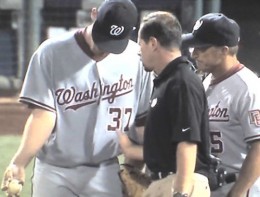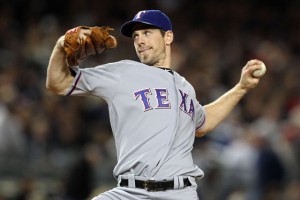In the past few weeks, we are hearing news reports linking the Nats to such luminary names as Cliff Lee, Matt Kemp, and Zack Greinke as off season targets. We are willing to go $125M/5years for Lee, we’d be “interested” in Kemp and we think we can put together a package of prospects for Greinke.
Now, I don’t mean to come off as a grumpy old Nats fan. Because I’m not; I follow this team intently, I have a rather unhealthy obsession with the minor league pitching rotations (hence the name of the blog), and I truly want the team to do better. But each of these rumors seems more ridiculous than the last and we (along with my fellow Nats bloggers) probably should have a bit of restraint when talking about the possibilities of actually acquiring these guys.
Zach Greinke is under contract to KC through 2012, has a limited no-trade clause and will probably cost (by various accounts) at least two young MLBers plus one or more additional prospects. I use the Roy Halladay-to the Phillies deal as a comparison. Halladay still had an entire year on the contract and Philly had to give up two high end prospects plus a third good young player in Kyle Drabek. If Greinke was in the last year of his contract (ala Cliff Lee this year) the price would be far less (indeed, the Rangers gave up their #1 prospect Justin Smoak but the other players were lesser ranked prospects).
Matt Kemp apparently is irritated with his club’s management, leading to spurrious trade rumors. But Kemp is even further away from free agency than Greinke, currently on a 2 year deal and then facing one more arbitration year before being cut loose by 2013.
Here’s the rub; the Nationals really don’t HAVE the kind of prospect depth that is required to make a deal for either player. Baseball America’s Jim Callis ranked his top 10 Nats prospects in a recent chat and he listed them in this order:
BA’s Jim Callis’ top 10 Nats prospects (the comments are his’)
1. Bryce Harper, of: Has monster power, though he won’t match Strasburg’s immediate impact.
2. Wilson Ramos, c: Matt Capps trade freed Ramos from being blocked by Joe Mauer with Twins.
3. Derek Norris, c: Still needs to polish bat and defense, but he has power and on-base ability.
4. A.J. Cole, rhp: First-round stuff earned him $2 million as a fourth-rounder.
5. Sammy Solis, lhp: Don’t be surprised if the $1 million second-rounder outperforms Cole.
6. Danny Espinosa, ss: Solid defender has cannon arm and surprising pop (40 HR in 2009-10).
7. Chris Marrero, 1b: Best proven all-around bat in system, though little defensive value.
8. Brad Peacock, rhp: Runs his fastball up to 95, flashes solid knuckle-curve and changeup.
9. Michael Burgess, of: Power potential remains impressive, but will he make enough contact?
10. Yunesky Maya, rhp: Former Cuban national team ace got $8 million big league contract.
Note he doesn’t mention our Minor leaguer of the year Tyler Moore, or our 12th round steal Robbie Ray.
Of this list, who is really trade-able? Probably not a single one of the top 6 right now, nor Maya or Ray. Perhaps Norris, if we find out that Jesus Flores is indeed healthy and we decide we can cash in one of the three of our young catchers. That leaves Marrero (who can barely play 1B and doesn’t hit nearly well enough to be a DH prospect), Peacock (22 and probably the best experienced minor league arm we have), Burgess (who now has 3 full pro seasons and still can’t hit a curveball), and Tyler Moore (great season but he did it as a 23-yr old in high-A). Our cache of early to mid 20s arms is good (Chico, Martis, Atilano, Stammen, Balester, Detwiler, Martin, Mock to start) but not one of them has proven they can produce at a sustained level without an ERA ballooning into the 5.00 era. Who wants to trade for a middle-relief right handed pitcher?
Lastly, there’s the Cliff Lee question. I just finished a blog posting showing how $125/5yrs is almost guaranteed to be an albatross of a contract. But ask yourself; why would Lee come here even if offered more money than Texas or New York will throw at him? Why did Mark Teixeira not come to Washington despite being (allegedly) offered more money than the Yankees? Simple reason: we’re not good enough yet. The team needs build its farm system and thus build its product on the field, while improving in the records and begin to attract better and better free agents. Yes, some players will just take whoever offers the most money, but most players want to get paid AND have a chance to win championships, pad their legacy, etc. If Ryan Zimmerman played for a winning team, he’d not only have more All Star appearances by now but he’d also probably have some MVP votes.
Now, if Strasburg was healthy next year, AND we had a legitimate #2 guy (could be Zimmermann, could be someone else), AND we knew that Marquis and Livan Hernandez would serve as good back-of-the-rotation innings eaters, and we resigned Dunn to preserve a pretty fearsome 3-4-5 lineup … well that sounds a lot more promising to a marquee Free Agent, right?
Now, think about how we’d possibly look 2 years from now at the beginning of 2012. Harper has torn through a year in the minors, Solis has made his mlb debut and looks like the 2nd coming of Madison Bumgarner. Strasburg looks great in rehab starts in Florida and in Potomac. Espinosa and Desmond are settled in to their roles, Zimmermann has bounced fully back from TJ surgery and looks great, and we’ve added an outfield bat to augment what we had in 2009. That’s an enticing story, a good young up and coming team that should be able to attract a serious FA starter to augment what is already here.

